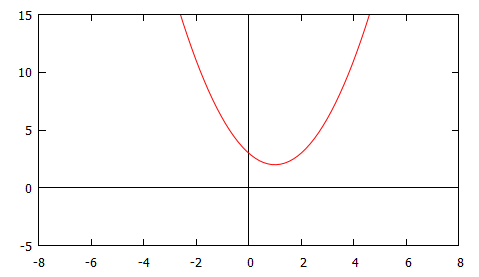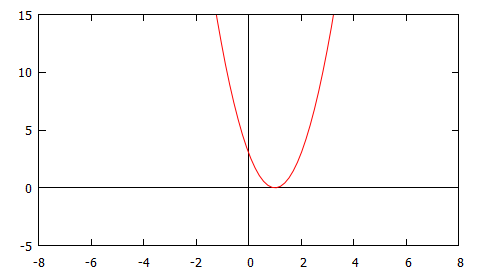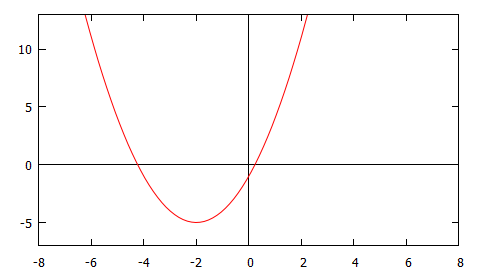The Quadratic Formula
The Quadratic Formula
An equation of the form $ax^2 + bx + c = 0$ can be solved using the quadratic formula. This is particularly useful when the left hand side cannot be easily factorised.
The quadratic formula is \[x = \frac{-b \pm \sqrt{b^2 - 4ac}}{2a}\]
Derivation of the formula
We can derive the formula by first multiplying the general quadratic equation $ax^2 + bx + c$ through by $a$ and then completing the square.
\begin{align} a^2x^2 + abx + ac &=a^2\left(x^2+\frac{b}{a}x+\frac{c}{a}\right)\\ &=a^2\left(\left(x+\frac{b}{2a}\right)^2-\left(\frac{b}{2a}\right)^2+\frac{c}{a}\right)\\ &=a^2\left(\left(x+\frac{b}{2a}\right)^2-\frac{b^2}{4a^2}+\frac{c}{a}\right)\\ &=a^2\left(x+\frac{b}{2a}\right)^2-\frac{b^2}{4}+ac\\ \end{align}
So we have to solve \[a^2\left(x+\frac{b}{2a}\right)^2-\frac{b^2}{4}+ac = 0\]
Rearranging this and making $x$ the subject will give the quadratic formula.
\begin{align} a^2\left(x+\frac{b}{2a}\right)^2&= \frac{b^2}{4}-ac\\\\ \Rightarrow \left(x+\frac{b}{2a}\right)^2 &=\frac{b^2}{4a^2}-\frac{c}{a} \\\\ \Rightarrow \left(x+\frac{b}{2a}\right)^2 &=\frac{b^2-4ac}{4a^2} \\\\ \Rightarrow x+\frac{b}{2a} &=\pm\sqrt{\frac{b^2-4ac}{4a^2}} \\\\ \Rightarrow x+\frac{b}{2a} &=\pm\frac{\sqrt{b^2-4ac}}{2a}\\\\ \Rightarrow x &=-\frac{b}{2a} \pm \frac{\sqrt{b^2-4ac}}{2a}\\\\ \Rightarrow x &= \frac{-b \pm \sqrt{b^2 - 4ac}}{2a} \end{align}
The Discriminant
The discriminant is used to find out how many real roots a quadratic has. The formula for the discriminant is \[b^2-4ac\] The quadratic formula uses the square root of the discriminant.
When the discriminant is $\gt 0$, there are two real roots.
When the discriminant is $=0$, there is one repeated real root.
When the discriminant is $\lt 0$, there are no real roots (however, there are two complex roots).
Worked Examples
Example 1
How many real roots does the equation $x^2-2x+3=0$ have?
Solution
$ a=1,\;b=-2,\;c=3$.
Calculate the discriminant: \begin{align} b^2-4ac &= (-2)^2-(4 \times1\times 3)\\ &=4-12\\ &=-8 \end{align}
The discriminant is negative, so there are no real roots.

This is the graph of $f(x) = x^2-2x+3$. The curve intersects the $x$-axis when $x^2-2x+3=0$. As it does not, there is no value of $x$ that satisfies $x^2-2x+3=0$ and the equation has no real roots.
Example 2
How many real roots does the equation $2x^2+4x-1=0$ have?
Solution
$ a=2,\;b=4,\;c=-1 $
\begin{align} b^2-4ac &= 4^2-4 \times2\times (-1)\\ &=16+8\\ &=24\\ \end{align}
The discriminant is positive, so the equation has two real roots.

This is the graph of $f(x) = 2x^2+4x-1$. The curve intersects the $x$-axis when $2x^2+4x-1=0$. We can see that it crosses the $x$ axis twice, so the equation has two roots.
Example 3
How many real roots does the equation $3x^2-6x+3=0$ have?
Solution
$ a=3,\;b=-6,\;c=3 $
\begin{align} b^2-4ac &= (-6)^2-(4 \times3\times3)\\ &=36-36\\ &=0 \end{align}
The discriminant is zero, so the equation has one repeated root.

This is the graph of $f(x) = 3x^2-6x+3$. The curve intersects the $x$-axis when $3x^2-6x+3=0$. We can see that it just touches the $x$-axis at its unique minimum and therefore has one repeated root.
Example 4
Solve the equation $x^2+4x-1=0$.
Solution
$ a=1,\;b=4,\;c=-1 $
First of all, the discriminant $b^2-4ac = 4^2 - 4 \times 1 \times (-1) = 20$ is positive, so we can say that the equation has two real roots. Now we use the quadratic formula to find them.
\begin{align} x &= \frac{-b \pm \sqrt{b^2 - 4ac} }{2a}\\\\ &= \frac{-4 \pm \sqrt{4^2 - (4\times1\times(-1))} }{2}\\\\ &= \frac{-4 \pm \sqrt{16+4} }{2}\\\\ &= \frac{-4 \pm \sqrt{20} }{2}\\\\ &= \frac{-4}{2} \pm \frac{2\sqrt{5} }{2}\\\\ &= -2 \pm \sqrt{5} \end{align}
The roots of the equation are $x_1=-2 + \sqrt{5}$ and $x_2 = -2 - \sqrt{5}$.

This is the graph of $f(x) = x^2+4x-1$. The curve intersects the $x$-axis when $x^2+4x-1=0$. We can see that it crosses the $x$ axis twice, so the equation has two roots.
Example 5
Solve the equation $3x^2-6x+3=0$.
Solution
$ a=3,\;b=-6,\;c=3 $
The discriminant $b^2 - 4ac = (-6)^2 - 4 \times 3 \times 3 = 0$, so the equation has a single, repeated root. Now we use the quadratic formula to find it.
\begin{align} x &= \frac{-b \pm \sqrt{b^2 - 4ac} }{2a}\\\\ &= \frac{6 \pm \sqrt{(-6)^2 - (4\times3\times3)} }{2\times3}\\\\ &= \frac{6 \pm \sqrt{36- 36} }{6}\\\\ &= \frac{6 \pm 0}{6}\\\\ &= \frac{6}{6}\\\\ &= 1 \end{align}
The only solution to the equation is $x=1$.

This is the graph of $f(x) = 3x^2-6x+3$. The curve intersects the $x$-axis when $3x^2-6x+3=0$. We can see that it touches the $x$ axis at its unique minimum, so the equation has one repeated root.
Video Example
Prof. Robin Johnson finds the discriminants of three quadratic equations, then uses the quadratic formula to solve them.
External Resources
- The Quadratic Formula worksheet at mathcentre.
- How to use the quadratic formula videos at Khan Academy.